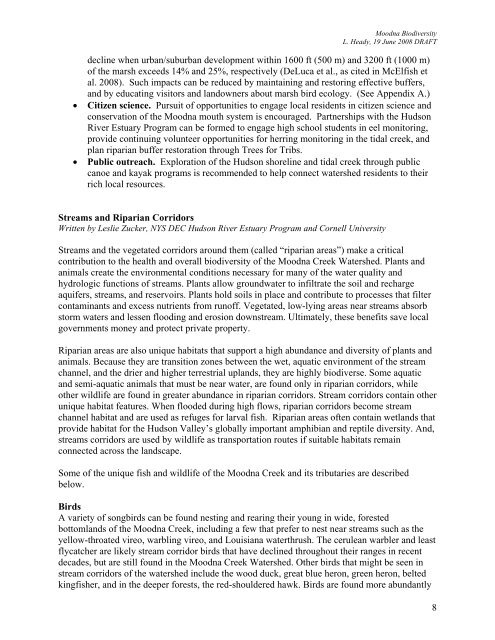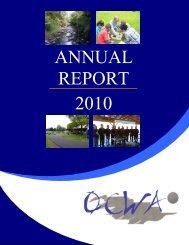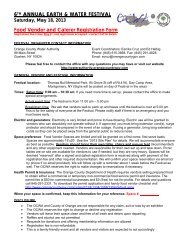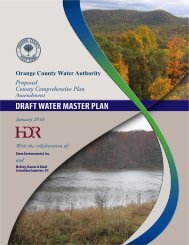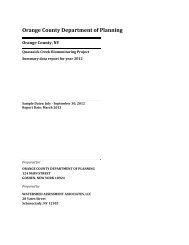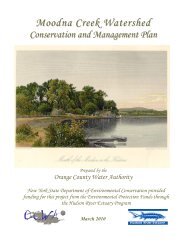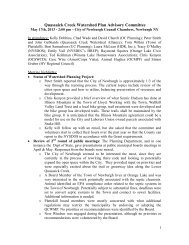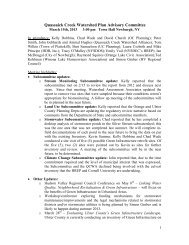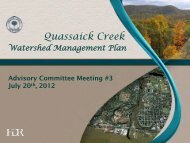Biodiversity of the Moodna Creek Watershed - Orange County Water ...
Biodiversity of the Moodna Creek Watershed - Orange County Water ...
Biodiversity of the Moodna Creek Watershed - Orange County Water ...
Create successful ePaper yourself
Turn your PDF publications into a flip-book with our unique Google optimized e-Paper software.
<strong>Moodna</strong> <strong>Biodiversity</strong><br />
L. Heady, 19 June 2008 DRAFT<br />
decline when urban/suburban development within 1600 ft (500 m) and 3200 ft (1000 m)<br />
<strong>of</strong> <strong>the</strong> marsh exceeds 14% and 25%, respectively (DeLuca et al., as cited in McElfish et<br />
al. 2008). Such impacts can be reduced by maintaining and restoring effective buffers,<br />
and by educating visitors and landowners about marsh bird ecology. (See Appendix A.)<br />
• Citizen science. Pursuit <strong>of</strong> opportunities to engage local residents in citizen science and<br />
conservation <strong>of</strong> <strong>the</strong> <strong>Moodna</strong> mouth system is encouraged. Partnerships with <strong>the</strong> Hudson<br />
River Estuary Program can be formed to engage high school students in eel monitoring,<br />
provide continuing volunteer opportunities for herring monitoring in <strong>the</strong> tidal creek, and<br />
plan riparian buffer restoration through Trees for Tribs.<br />
• Public outreach. Exploration <strong>of</strong> <strong>the</strong> Hudson shoreline and tidal creek through public<br />
canoe and kayak programs is recommended to help connect watershed residents to <strong>the</strong>ir<br />
rich local resources.<br />
Streams and Riparian Corridors<br />
Written by Leslie Zucker, NYS DEC Hudson River Estuary Program and Cornell University<br />
Streams and <strong>the</strong> vegetated corridors around <strong>the</strong>m (called “riparian areas”) make a critical<br />
contribution to <strong>the</strong> health and overall biodiversity <strong>of</strong> <strong>the</strong> <strong>Moodna</strong> <strong>Creek</strong> <strong><strong>Water</strong>shed</strong>. Plants and<br />
animals create <strong>the</strong> environmental conditions necessary for many <strong>of</strong> <strong>the</strong> water quality and<br />
hydrologic functions <strong>of</strong> streams. Plants allow groundwater to infiltrate <strong>the</strong> soil and recharge<br />
aquifers, streams, and reservoirs. Plants hold soils in place and contribute to processes that filter<br />
contaminants and excess nutrients from run<strong>of</strong>f. Vegetated, low-lying areas near streams absorb<br />
storm waters and lessen flooding and erosion downstream. Ultimately, <strong>the</strong>se benefits save local<br />
governments money and protect private property.<br />
Riparian areas are also unique habitats that support a high abundance and diversity <strong>of</strong> plants and<br />
animals. Because <strong>the</strong>y are transition zones between <strong>the</strong> wet, aquatic environment <strong>of</strong> <strong>the</strong> stream<br />
channel, and <strong>the</strong> drier and higher terrestrial uplands, <strong>the</strong>y are highly biodiverse. Some aquatic<br />
and semi-aquatic animals that must be near water, are found only in riparian corridors, while<br />
o<strong>the</strong>r wildlife are found in greater abundance in riparian corridors. Stream corridors contain o<strong>the</strong>r<br />
unique habitat features. When flooded during high flows, riparian corridors become stream<br />
channel habitat and are used as refuges for larval fish. Riparian areas <strong>of</strong>ten contain wetlands that<br />
provide habitat for <strong>the</strong> Hudson Valley’s globally important amphibian and reptile diversity. And,<br />
streams corridors are used by wildlife as transportation routes if suitable habitats remain<br />
connected across <strong>the</strong> landscape.<br />
Some <strong>of</strong> <strong>the</strong> unique fish and wildlife <strong>of</strong> <strong>the</strong> <strong>Moodna</strong> <strong>Creek</strong> and its tributaries are described<br />
below.<br />
Birds<br />
A variety <strong>of</strong> songbirds can be found nesting and rearing <strong>the</strong>ir young in wide, forested<br />
bottomlands <strong>of</strong> <strong>the</strong> <strong>Moodna</strong> <strong>Creek</strong>, including a few that prefer to nest near streams such as <strong>the</strong><br />
yellow-throated vireo, warbling vireo, and Louisiana waterthrush. The cerulean warbler and least<br />
flycatcher are likely stream corridor birds that have declined throughout <strong>the</strong>ir ranges in recent<br />
decades, but are still found in <strong>the</strong> <strong>Moodna</strong> <strong>Creek</strong> <strong><strong>Water</strong>shed</strong>. O<strong>the</strong>r birds that might be seen in<br />
stream corridors <strong>of</strong> <strong>the</strong> watershed include <strong>the</strong> wood duck, great blue heron, green heron, belted<br />
kingfisher, and in <strong>the</strong> deeper forests, <strong>the</strong> red-shouldered hawk. Birds are found more abundantly<br />
8


